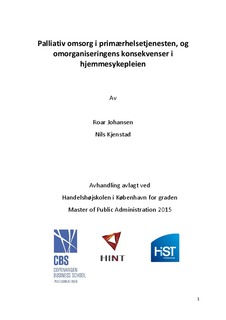| dc.description.abstract | «Palliativ omsorg i primærhelsetjenesten, og omorganiseringens konsekvenser i hjemmesykepleien»
Dette har vært en studie av reaksjoner blant medarbeiderne når palliativ behandling implementeres i hjemmesykepleien, og hvordan arbeidsmiljøet blir påvirket av denne prosessen. Bakgrunn: I denne masteroppgaven undersøkte vi konsekvensene av samhandlingsreformen i den kommunale hjemmetjenesten, da med fokus på behandling av palliative kreftpasienter. Samhandlingsreformens konsekvens har vært en oppgaveforskyvning av pasientbehandling og oppfølging, fra sykehus til kommunehelsesektoren. I vår casestudie studerte vi hvordan hjemmetjenesten har opplevd oppgaven om et sømløst forløp til den palliative pasienten uavhengig av omsorgsnivå. Vi samlet informanter fra hjemmesykepleien i to nabokommuner, som har organisert den palliative omsorgen på ulike måter. På den måten fikk vi muligheten til å utføre en komparativ studie, for å få en bredde i våre funn. Teori: For å kunne gjennomføre en god analyse av hvilke reksjoner implementeringen av samhandlingsreformen har ført til og hvilke strukturelle endringer som også har vært en følge av dette, har det vært viktig med et godt teoretisk bakteppe for argumentasjonen vi kom fram til. Kommunens måte å håndtere de nye utfordringene vil være preget av den strukturelle rammen kommunen befinner seg i, endringsprosessene som er gjennomført og hvordan den strukturelle endringen har preget arbeid, utvikling og implementering. Vi så det hensiktsmessig å ha ny-institusjonell teori som utgangspunkt for analysen, med fokus på tre-pilar systemet, effektivitet og legitimitet. Vi brukte de underliggende teoriene vi har presentert som et nyttig teoretisk utgangspunkt, for å analysere problemstillingene vi laget i denne oppgaven.
Metode:
Det ble benyttet en komparativ kvalitativ metode med casestudie, der 6 informanter er fra kommunen vi ønsket å undersøke, og 5 informanter er fra en sammenligningskommune. Datamaterialet ble analysert tematisk og ved hjelp av både lydopptak og transkribering under selve analyseringen. Vi fant den hermenautiske tilnærmingen naturlig, da fortolkningen og relasjonene som inngikk i prosessen, var sentralt for hvordan situasjonen ble håndtert.
Konklusjon/resultat:
Kommunene vi undersøkte, valgte ulike måter å strukturere hjemmesykepleiens tjenester på. Nesodden oppga trygghetsfølelse av å ha en kompetansegruppe lett tilgjengelig, og økt interesse for de palliative pasientgruppene. Positiv omtale og tilbakemeldinger ble oppfattet som belønninger for deres innsats. Informantene fra Frogn, ga uttrykk for å oppleve økte krav om kompetanse og engasjement som motivasjon i jobben. De savnet også en sterkere ledelse innenfor det palliative satsningsområdet. Alle informanter savner innovativ og økonomisk satsning, for å kunne øke kvalitet og sikkerhet i jobben. Vi tror at videre forskning bør satse på en kvantitativ studie, som inkluderer alle kommuner i landet. Undersøkelsesskjemaer kan avdekke ulike funn, basert på befolkningsdata, geografi og økonomiske ressurser. Dette vil skape et god oversikt over hvor vellykket implementeringen av kommunal palliasjon har vært.
“Palliation medicine in the primary health care, and the consequences of reorganizing the municipal home nursing services” We analyzed studied various ways to perform palliation care in the municipal health care system, and its impact on the home health care system. Context Since the Coordination reform was implemented on January 1st 2012, the municipal health care system has been given increased responsibility for the health care services. The municipalities are now required to provide more palliative treatment and care, due to the transfer of tasks between specialist health services and primary heath and care services in Norway. We present the background of the study, its mandate and the main features of its prosecution. We review the main contents and present the analyses in the different chapters. We outline the data and the records on which the study is based. The study`s main questions The key questions posed in this study relate to the migration and changes in tasks in palliation care services in the municipalities in relation to the specialist health service. The changes are specified as tasks or responsibilities that are transferred and taken over by the municipally. Of central importance are questions relating to possible work implications of changes in the municipally portfolio of responsibilities and a gradual integration of new client categories, especially cancer patients receiving palliation care. Q1: What kind of reactions might appear in the municipality home nurses working environment, at the implementation of new specialist tasks? Q2: What are the implications on the organizational structure, stemming from a change in the municipality work environment from stability to the dynamic complexity? Method We take a qualitative methodical approach in our case studies, by conducting individual interviews and collecting data from home nursing employees at Nesodden and Frogn municipalities.The participants contributed with their extensive experience in working with palliation care at the municipally home care. The data was analyzed by thematic analyses.
Results We would like to present the following analysis from our studies: The home nurses in Nesodden and Frogn experienced an increase of interest and pride in their work along a rise in palliative care competence. The two municipalities Nesodden and Frogn perform palliation care differently and enable us to generalize our results. Nesodden has established their own palliation team consisting of an oncologist and an oncology nurse, while Frogn has given the palliation care tasks to all home nurses at the municipally. The result raises ethical issues in reallocation of labour recourses allocation and its consequences. Another critical issue is how to treat all chronic ill patients fairlyin the municipally system, when certain diseases require more attention than others. Finally we found a rise in labour autonomy and responsibility as another outcome of the municipality level reorganization of work structure. | nb_NO |
